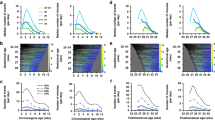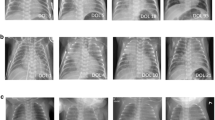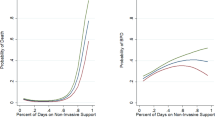Abstract
Previous studies of the maturation of periodic breathing cycle duration (PCD) with postnatal age in infants have yielded conflicting results. PCD is reported to fall in term infants over the first 6 mo postnatally, whereas in preterm infants PCD is reported either not to change or to fall. Contrary to measured values, use of a theoretical respiratory control model predicts PCD should increase with postnatal age. We re-examined this issue in a longitudinal study of 17 term and 22 preterm infants. PCD decreased exponentially from birth in both groups, reaching a plateau between 4 and 6 mo of age. In preterm infants, PCD fell from a mean of 18.3 s to 9.8 s [95% confidence interval (CI) is ± 3.2 s]. In term infants, PCD fell from 15.4 s to 10.1 s (95% CI is ± 3.1 s). The higher PCD at birth in preterm infants, and the similar PCD value at 6 mo in the two groups, suggest a more rapid maturation of PCD in preterm infants. This study confirms that PCD declines after birth. The disagreement between our data and theoretical predictions of PCD may point to important differences between the respiratory controller of the infant and adult.
Similar content being viewed by others
Log in or create a free account to read this content
Gain free access to this article, as well as selected content from this journal and more on nature.com
or
Abbreviations
- AS:
-
active sleep
- GA:
-
gestational age
- LG:
-
loop gain
- PB:
-
periodic breathing
- PCA:
-
post-conceptional age
- PCD:
-
periodic breathing cycle duration
- PNA:
-
postnatal age
- QS:
-
quiet sleep
- SP:
-
sleep position
- SS:
-
sleep state
- ST:
-
stimulus type
References
Wilkinson MH, Cranage S, Berger PJ, Blanch N, Adamson TM 1995 Changes in the temporal structure of periodic breathing with postnatal development in preterm infants. Pediatr Res 38: 533–538
Rigatto H 2003 Periodic breathing. In: Mathew OP (ed) Respiratory Control and Disorders in the Newborn. Marcel Dekker Inc, New York, pp 237–272
Khoo MC, Kronauer RE, Strohl KP, Slutsky AS 1982 Factors inducing periodic breathing in humans: a general model. J Appl Physiol 53: 644–659
Nugent ST, Finley JP 1987 Periodic breathing in infants: a model study. IEEE Trans Biomed Eng 34: 482–485
Wilkinson MH, Cranage S, Adamson TM, Wilson FE, Strangward A, Walker AM 1986 Incidence and temporal characteristics of oscillatory breathing patterns in full term neonates. IEEE/Eighth Annual Conf Eng Med. Biol Soc 2: 1257–1262
Fleming PJ, Goncalves AL, Levine MR, Woollard S 1984 The development of stability of respiration in human infants: changes in ventilatory responses to spontaneous sighs. J Physiol 347: 1–16
Barrington KJ, Finer NN, Wilkinson MH 1987 Progressive shortening of the periodic breathing cycle duration in normal infants. Pediatr Res 21: 247–251
Glotzbach SF, Tansey PA, Baldwin RB, Ariagno RL 1989 Periodic breathing cycle duration in preterm infants. Pediatr Res 25: 258–261
Sovik S, Lossius K 2004 Development of ventilatory response to transient hypercapnia and hypercapnic hypoxia in term infants. Pediatr Res 55: 302–309
Anders T, Emde R, Parmelee A 1971 A manual of standardized terminology, techniques and criteria for scoring of states of sleep and wakefulness in newborn infants. UCLA Brain Information Services/BRI Publications Office, Los Angeles
Horne RS, Sly DJ, Cranage SM, Chau B, Adamson TM 2000 Effects of prematurity on arousal from sleep in the newborn infant. Pediatr Res 47: 468–474
Kelly DH, Shannon DC 1979 Periodic breathing in infants with near-miss sudden infant death syndrome. Pediatrics 63: 355–360
Rigatto H, Brady JP 1972 Periodic breathing and apnea in preterm infants. I. Evidence for hypoventilation possibly due to central respiratory depression. Pediatrics 50: 202–218
Al-Matary A, Kutbi I, Qurashi M, Khalil M, Alvaro R, Kwiatkowski K, Cates D, Rigatto H 2004 Increased peripheral chemoreceptor activity may be critical in destabilizing breathing in neonates. Semin Perinatol 28: 264–272
Hajak G, Klingelhofer J, Schulz-Varszegi M, Matzander G, Sander D, Conrad B, Ruther E 1994 Relationship between cerebral blood flow velocities and cerebral electrical activity in sleep. Sleep 17: 11–19
Kuboyama T, Hori A, Sato T, Mikami T, Yamaki T, Ueda S 1997 Changes in cerebral blood flow velocity in healthy young men during overnight sleep and while awake. Electroencephalogr Clin Neurophysiol 102: 125–131
Walker AM 1993 Circulatory transitions at birth and the control of the neonatal circulation. Fetus and Neonate. Physiology and Clinical Applications. Cambridge University Press, New York, pp 160–196
Hall MJ, Xie A, Rutherford R, Ando S-I, Floras JS, Bradley TD 1996 Cycle length of periodic breathing in patients with and without heart failure. Am J Respir Crit Care Med 154: 376–381
West JB, Peters RM, Aksnes G, Maret KH, Milledge JS, Schoene RB 1986 Nocturnal periodic breathing at altitudes of 6300 and 8050m. J Appl Physiol 61: 280–287
Wilkinson MH, Berger PJ, Blanch N, Brodecky V, Jones C 1996 Source of respiratory drive during periodic breathing in lambs. Respir Physiol 104: 115–126
Wilkinson MH, Sia KL, Skuza EM, Brodecky V, Berger PJ 2005 Impact of changes in inspired oxygen and carbon dioxide on respiratory instability in the lamb. J Appl Physiol 98: 437–446
Author information
Authors and Affiliations
Corresponding author
Additional information
Supported by grants from the National Health and Medical Research Council of Australia, Grant Number 34836 and 194403, and the National SIDS Council of Australia, Grant G94-13/161.
Rights and permissions
About this article
Cite this article
Wilkinson, M., Skuza, E., Rennie, G. et al. Postnatal Development of Periodic Breathing Cycle Duration in Term and Preterm Infants. Pediatr Res 62, 331–336 (2007). https://doi.org/10.1203/PDR.0b013e3180db29e5
Received:
Accepted:
Issue date:
DOI: https://doi.org/10.1203/PDR.0b013e3180db29e5
This article is cited by
-
Clinical associations with immature breathing in preterm infants: part 2—periodic breathing
Pediatric Research (2016)
-
Altitude, oxygen and the definition of bronchopulmonary dysplasia
Journal of Perinatology (2012)



